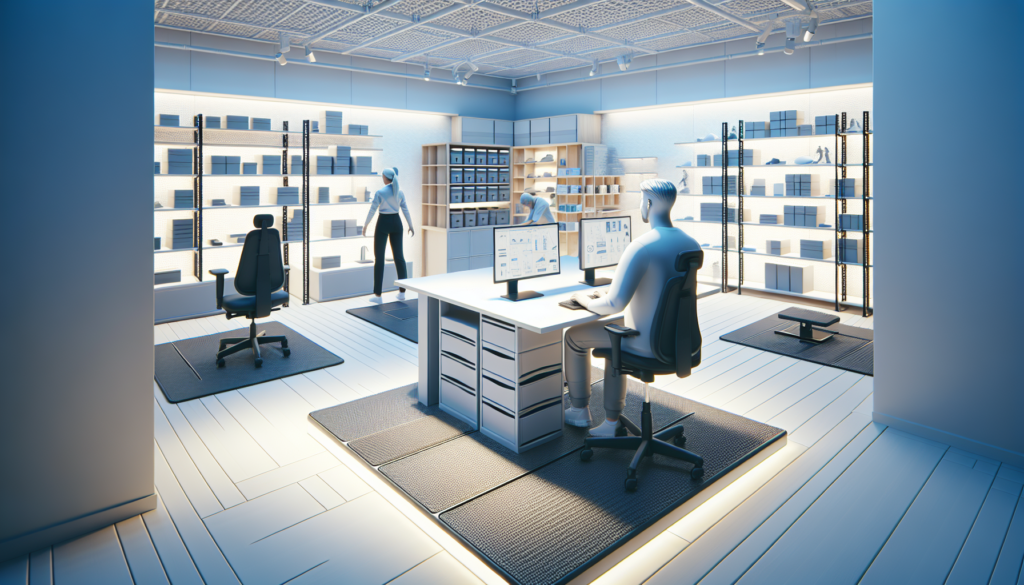Retail environments are fast-paced and physically demanding, often requiring employees to stand for long hours, move heavy items, and perform repetitive tasks. Preventing workplace strain in such settings is crucial for maintaining employee health, productivity, and overall job satisfaction.
Smart furniture choices and strategic layouts play a significant role in achieving these goals. Here’s how thoughtful furniture and layout decisions can help to prevent workplace strain in retail environments.
1. Ergonomic Furniture
Ergonomic furniture is designed to support the natural posture and movements of the human body, reducing the risk of musculoskeletal disorders (MSDs) and other work-related injuries.
- Adjustable Workstations: Adjustable height counters and workstations allow employees to alternate between sitting and standing positions. This flexibility helps to reduce the strain associated with prolonged standing and can be adjusted to fit the height of different employees.
- Supportive Seating: For areas where employees need to sit down, such as checkout counters or customer service desks, ergonomic chairs with lumbar support, adjustable height, and cushioned seating can significantly reduce back and neck strain.
- Anti-Fatigue Mats: Placing anti-fatigue mats in areas where employees stand for long periods, such as behind cash registers or at packing stations, can help to reduce foot, leg, and lower back discomfort. These mats encourage subtle movements that improve circulation and reduce muscle fatigue.
2. Efficient Layout Design
The layout of a retail space impacts how employees move and work. An efficient layout minimizes unnecessary movements and awkward postures, reducing strain and injury risk. It can help to work with a company that’s experienced in retail fitout designs who’ll be able to make the business look amazing while also creating the best layout for the space.
- Optimized Workflow: Design the layout to streamline workflow and reduce the need for excessive reaching, bending, or twisting. For instance, placing frequently used items within easy reach and organizing workstations logically can enhance efficiency and reduce physical strain.
- Clear Pathways: Ensure that pathways are wide and clear of obstacles. This reduces the risk of tripping and allows employees to move freely without having to navigate around clutter or tight spaces.
- Accessible Storage: Position storage solutions, such as shelves and racks, at convenient heights. Heavy or frequently accessed items should be stored between waist and shoulder height to minimize the need for awkward lifting or stretching.
3. Equipment and Tools
The right equipment and tools can significantly reduce the physical demands placed on retail employees.
- Lifting Aids: Use mechanical lifting aids, such as hand trucks, dollies, and pallet jacks, to move heavy items. This reduces the strain on employees’ backs and prevents lifting-related injuries.
- Ergonomic Tools: Provide ergonomically designed tools, such as box cutters with comfortable grips and barcode scanners that reduce wrist strain. These tools help to prevent repetitive strain injuries and enhance overall efficiency.
4. Break Areas and Rest Opportunities
Incorporating adequate break areas and encouraging regular rest breaks are essential for preventing workplace strain.
- Comfortable Break Areas: Designate comfortable break areas where employees can rest and recharge. These areas should be equipped with supportive seating, tables, and amenities that promote relaxation.
- Scheduled Breaks: Encourage employees to take regular breaks to rest and stretch. Short, frequent breaks are more effective at preventing fatigue and strain than fewer, longer breaks.
5. Employee Training and Awareness
Educating employees about ergonomic practices and the importance of maintaining good posture can significantly reduce workplace strain.
- Ergonomics Training: Provide training on proper lifting techniques, posture, and the use of ergonomic equipment. Employees who understand the principles of ergonomics are more likely to adopt healthy work habits.
- Awareness Programs: Implement awareness programs that remind employees to take care of their physical well-being. Posters, workshops, and regular reminders can reinforce the importance of ergonomics in the workplace.
Conclusion
Smart furniture choices and well-thought-out layouts are crucial for preventing workplace strain in retail environments. By investing in ergonomic furniture, designing efficient layouts, providing the right tools, creating comfortable break areas, and educating employees, retail businesses can create a healthier and more productive work environment. These measures not only enhance employee well-being but also reduce the risk of injuries, improve job satisfaction, and ultimately contribute to the success of the business.

